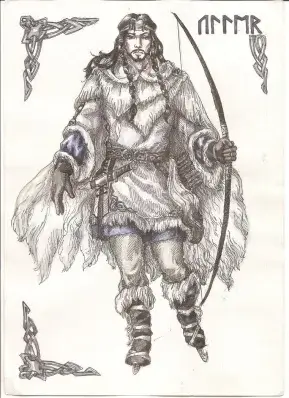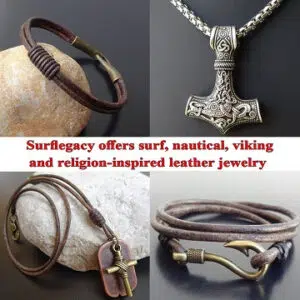Ullr, the God of Hunting, Justice, and Winter, known as Uller in Old Norse mythology, holds a significant role in the Norse pantheon. Residing in the realm of Ydalir, Ullr is revered for his exceptional skills in archery and skiing. Born to Sif and the jotunn Orvandil, he is also the stepson of the mighty Thor. Ullr’s union with the giantess Skadi forms a connection between the gods and the giants.
The Enigmatic Position of Ullr in Norse Mythology
Despite his importance as the god of the hunt and his extraordinary abilities, Ullr’s position within the Norse pantheon remains somewhat enigmatic. Unlike well-known gods like Odin or Thor, there are limited myths and legends centered around Ullr, making him a lesser-known figure in recent times.
However, traces of his presence can still be found in certain Scandinavian place names, indicating that he was once worshipped in southern Norway and central Sweden, though to a lesser extent in Denmark. This suggests that Ullr, during the Viking Age, was an ancient deity gradually fading into obscurity.
Ullr’s Brief Reign and Exile from Asgard
In alternative mythological accounts, it is mentioned that Ullr briefly ruled Asgard in place of Odin. The other gods, in a collective assembly, removed Odin from power due to his indiscretions in a romantic affair. However, Ullr’s reign was short-lived, lasting only a decade, as Odin eventually reclaimed his position, banishing Ullr from Asgard.
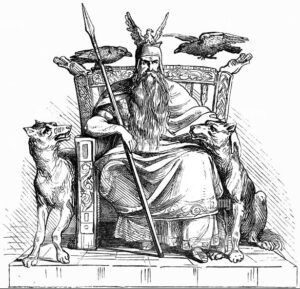
Odin
Exiled, Ullr sought solace in Sweden where he quickly gained a reputation as a formidable sorcerer and magician. It is said that he possessed a magical bone inscribed with potent spells, allowing him to transform it into a ship and traverse vast seas.
Ullr’s Former Importance and Worship
Despite limited information about Ullr’s attributes and adventures in written sources, the significance of his name implies his former importance as a deity. He was primarily revered before the Viking Age, particularly in central Sweden and southern Norway, where place names featuring Ullr’s name can be found. Examples include Ullevål, Ullevi, Ullared, Ullensaker, and Ullensvang.
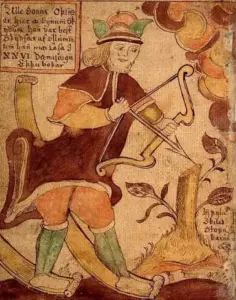
Ullr’s depiction from an old manuscript
The establishment of farms named Huseby coincided with the time frame from the early 6th century to the beginning of the 9th century. Ullr sanctuaries, as indicated by place names, emerged between the early 6th century and approximately 850. The expansion of Huseby settlements and the worship of Ullr seemed to align with each other.
Ullr as a Sky God and Winter Manifestation
According to some interpretations, Ullr may have embodied the personification of the winter sky, similar to Tyr, considering his association with archery and skiing in Snorri’s and Saxo’s writings.
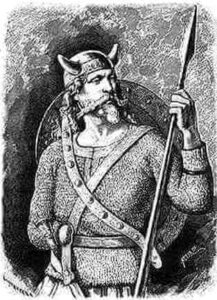
Tyr
However, Ullr’s presence in place names is scarce in Iceland and Denmark, leading to the proposition that he might have been one of the names for the older Norse sky god, possibly synonymous with Tyr.
Ydalir, Ullr’s abode, is mentioned only once in the fifth verse of Grimnismál in the Old Edda, emphasizing Ullr’s importance in the poet’s eyes.
Ullr’s Ship and Conflicting Myths
According to poetic conventions, Ullr’s ship is believed to be named Shield, leading poets to use kennings like “Ullr’s ship,” “Ullr’s boat,” or “Ullr’s vessel” to refer to a shield. However, some myths suggest that Ullr may have used his shield as a sled instead of skiing, introducing possible confusion in interpretation.
The Conflict Between Ullr and Odin
In Saxo’s Gesta Danorum, it is claimed that Odin was exiled after his assault on the Russian princess Rind, seeking to conceive a son with her to avenge the death of his son Baldr.
During Odin’s absence, Ullr, known as Ollerus, was elected as the chief and Odin’s successor, reigning over Asgard for a decade. Odin eventually returned, forcing Ullr to flee to Sweden where he met his demise at the hands of the Danes.
This account by Saxo echoes Ullr’s earlier significance and serves as a reminder of a religious transition in the North that has been forgotten. Similar instances of Odin’s temporary absence can be found in other Norse myths, such as when he stayed away for an extended period, resulting in his two brothers dividing his possessions and his wife Frigg between them.
It is important to note that Saxo’s attempt to transform the gods into historical figures may have distorted the original myth, making it incomprehensible in contemporary understanding.
The conflict between Ullr and Odin may be interpreted as a seasonal myth, where Ullr, representing winter, temporarily replaces Odin or assumes his winter aspect for half of the year.
Both gods are known by dual names (Od/Odin and Ull/Ullin), and both possess magical abilities. While Odin practices seidr, as seen in his attack on Rind, Ullr’s legendary skill as a wizard enables him to cross vast waters using a bone inscribed with powerful spells, akin to sailing on a ship.
The conflict between the two gods may trace back to a distant memory of Ullr, Heimdall, Tyr, and others being supplanted by Odin, a warrior-like deity accompanied by death gods, hanged men, and fallen warriors.
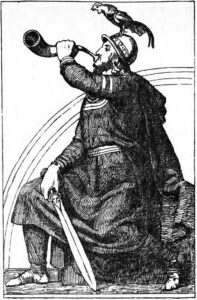
Heimdall
Ullr Today
Within the winter skiing community of Europe, Ullr holds a revered position as the Guardian Patron Saint of Skiers, known as the “Schutzpatron der Skifahrer” in German. Skiers, both recreational and professional, as well as ski patrols, commonly wear Ullr medallions or ski medals adorned with his image. These talismans depict the god on skis, wielding a bow and arrow, and are believed to bring luck and protection to skiers across Europe and other regions.
Breckenridge, Colorado, has embraced Ullr’s mythology and celebrates an annual event called “Ullr Fest” since 1963. This week-long festival, held in January, aims to gain Ullr’s favor and bring abundant snowfall to the historic ski town. Ullr Fest has become a cherished tradition, bringing together locals and visitors in their shared passion for winter sports and their reverence for Ullr.
Ullr’s influence extends beyond traditional customs into the realm of popular culture. In the realm of gaming, Ullr appears as a playable character in the video game Smite, allowing players to embody his persona and engage in thrilling battles inspired by Norse mythology.
Furthermore, Ullr’s presence is felt in the television series The Almighty Johnsons, where he is depicted as being reincarnated as Mike Johnson, played by Tim Balme. This imaginative portrayal highlights Ullr’s enduring relevance and his ability to transcend ancient mythology, resonating with modern audiences through captivating storytelling.
These cultural expressions demonstrate Ullr’s lasting impact and continuing significance within the winter sports community, gaming enthusiasts, and television viewers. By bridging the gap between ancient mythology and contemporary entertainment, Ullr’s legend continues to inspire and captivate individuals across various mediums and cultural contexts.
Shop Viking Jewelry
Are passionate about Vikings or Norse Mythology?
Finding the ideal piece of Viking Jewelry can be challenging and time-consuming, especially if you lack inspiration or don’t know where to look.
Surflegacy, has you covered. We have a wide range of Handmade Jewelry in various styles, shapes, colors, and materials, to accentuate your Viking spirit and look. Do not hesitate to visit our selection HERE
Whatever you wear, you’ll find the ideal trendy piece to complement your wardrobe. Our jewelry is designed to be worn every day, no matter where you go or what season is. Are you ready to step up your wardrobe game?

